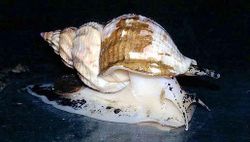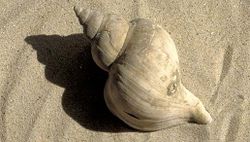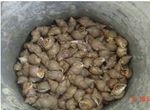Common whelk
| Common whelk |
|---|

|
| Scientific Classification |
|
| Binomial Name |
|
Buccinum undatum |
| ' |
The Common Whelk is a species of whelk sea snails known by the scientific name Buccinum undatum. Many whelk, like the common whelk, have historically been used, or are still used, by humans for food. Although a number of whelks are relatively large and in the family Buccinidae, the word whelk is also applied to some other marine gastropod mollusk species within several families of sea snails that are not very closely related.
Body Design
Whelk is characterized by a thick, spirally, coiled, shell and a large muscular foot. The bottom surface of the foot is made with slime substance, so it's easy for them to travel over the ocean bottom. It's shell has 6 to 8 whorls with spiral ridges. It is typically chalky grey to grey-yellow in color with irregular light and dark segments. The shape of the entrance hole is oval, and can be sealed by a hard plate called the operculum (attached to the top of the foot). [1]
Life Cycle
Whelk can be found at the low water mark on spring tides. They live on a wide variety of hard and soft substrates, like rock, cobbles, gravel, and muddy and coarse sand. They spend some of their time on the softer sediments. [2] The sexes of the whelk are separated. They breed between October and May, and the eggs are attached to rocks, shells, and stones. Each capsule contains about 1000 eggs, and the capsules of several females are grouped together in large masses of over 2000. Only few eggs will develop, and most eggs are used as a source of food by the growing embryos. [3] Common whelk live for about 10 years. [4]
Ecology
Whelks are carnivorous scavengers often use their sense of smell to locate food, they can travel in search of food for several hundred meters. They usually feed on tube-dwelling polychaetes like Lanice conchilega. They attack cockles using their foot to choke the cockle or using the lip to push the shell valves apart. It takes only 1 hour. Some similar species the common whelk cannot drill into the shell of its prey as it lacks a pedal boring organ. 2 cockles per whelk per week are their maximum; to occur during the spring, incidentally this is when maximum growth occurs. Adult whelks are a food for a range of species including cod, dogfish, crabs, rays, flatfish and starfish. Predators of whelk eggs include sea urchins and starfish. It should be noted here that the empty shells of whelks are often inhabited by hermit crabs and such shells are an integral part of a hermit crabs life. [5]
Fishing activity
When whelks are the target species whelk pots are used, a very small piece is also taken as bycatch. The most common whelks pots used in district are recycled 25l plastic containers. Whelks are attracted into the pot by the smell of the baits. It takes only 1 to 3 day basis. If the pots are left for like several days and the bait is used up catches decrease, It's probably because the whelks escape and search of another food source. Whelks are fished all year round. The highest catch rates of whelks is between February and April. This shows when the whelks are most actively feeding. In the autumn lower catch rates are seen, this is probably due to two factors; there will be increased disturbance of the pots on the sea bed due to the poorer weather conditions and at this time the whelks are breeding and thus feeding activity is likely to decrease. [6]
References
- ↑ Whelk (Buccinum undatum) Emerging Species Profile Sheets. Pdf. Announced in August, 1999. Unknown Author.
- ↑ Whelk (Buccinum undatum) Common Whelk: Buccinum undatum. Web. Announced in August, 1999. Unknown Author.
- ↑ Ager, O.E.D Common whelk - Buccinum undatum. Web. Announced in December, 2001.
- ↑ WhelkCommon whelk - Buccinum undatum. Web. Announced in December, 2002.
- ↑ Common whelk: Buccinum undatum (L.) Sussex Inshore Fisheries and Conservative Authority. Web. Announced in November, 2008.
- ↑ Learn about whelks&relatives A Snail's Odyssey. Web. Announced in November, 2008.



